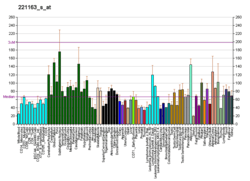Carbohydrate-responsive element-binding protein
Carbohydrate-responsive element-binding protein (ChREBP) also known as MLX-interacting protein-like (MLXIPL) is a protein that in humans is encoded by the MLXIPL gene.[5][6] The protein name derives from the protein's interaction with carbohydrate response element sequences of DNA.
Function
This gene encodes a basic helix-loop-helix leucine zipper transcription factor of the Myc / Max / Mad superfamily. This protein forms a heterodimeric complex and binds and activates, in a glucose-dependent manner, carbohydrate response element (ChoRE) motifs in the promoters of triglyceride synthesis genes.[6]
ChREBP is activated by glucose, independent of insulin.[7] In adipose tissue, ChREBP induces de novo lipogenesis from glucose in response to a glucose flux into adipocytes.[8][7] In the liver, glucose induction of ChREBP promotes glycolysis and lipogenesis.[7]
Clinical significance
This gene is deleted in Williams-Beuren syndrome, a multisystem developmental disorder caused by the deletion of contiguous genes at chromosome 7q11.23.[6]
Excess expression of ChREBP in the liver due to metabolic syndrome or type 2 diabetes can lead to steatosis in the liver.[7] In non-alcoholic fatty liver disease, about 25% of total liver lipids result from de novo synthesis (synthesis of lipids from glucose).[9] High blood glucose and insulin enhance lipogenesis in the liver by activation of ChREBP and SREBP-1c, respectively.[9]
Chronically elevated blood glucose can activate ChREBP in the pancreas can lead to excessive lipid synthesis in beta cells, increasing lipid accumulation in those cells, leading to lipotoxicity, beta-cell apoptosis, and type 2 diabetes.[10]
Role in glycolysis
ChREBP is translocated to the nucleus and binds to DNA after dephosphorylation of a p-Ser and a p-Thr residue by PP2A, which itself is activated by Xylulose-5-phosphate. Xu5p is produced in the pentose phosphate pathway when levels of Glucose-6-phosphate are high (the cell has ample glucose). In the liver, ChREBP mediates activation of several regulatory enzymes of glycolysis and lipogenesis including L-type pyruvate kinase (L-PK), acetyl CoA carboxylase, and fatty acid synthase.
References
- GRCh38: Ensembl release 89: ENSG00000009950 - Ensembl, May 2017
- GRCm38: Ensembl release 89: ENSMUSG00000005373 - Ensembl, May 2017
- "Human PubMed Reference:". National Center for Biotechnology Information, U.S. National Library of Medicine.
- "Mouse PubMed Reference:". National Center for Biotechnology Information, U.S. National Library of Medicine.
- Meng X, Lu X, Li Z, Green ED, Massa H, Trask BJ, Morris CA, Keating MT (Jan 1999). "Complete physical map of the common deletion region in Williams syndrome and identification and characterization of three novel genes". Hum Genet. 103 (5): 590–9. doi:10.1007/s004390050874. PMID 9860302.
- "Entrez Gene: MLXIPL MLX interacting protein-like".
- Xu X, So JS, Park JG, Lee AH (2013). "Transcriptional control of hepatic lipid metabolism by SREBP and ChREBP". SEMINARS IN LIVER DISEASE. 33 (4): 301–311. doi:10.1055/s-0033-1358523. PMC 4035704. PMID 24222088.
- Czech MP, Tencerova M, Pedersen DJ, Aouadi M (2013). "Insulin signalling mechanisms for triacylglycerol storage". Diabetologia. 56 (5): 949–964. doi:10.1007/s00125-013-2869-1. PMC 3652374. PMID 23443243.
- Ortega-Prieto P, Postic C (2019). "Carbohydrate Sensing Through the Transcription Factor ChREBP". Frontiers in Genetics. 10: 472. doi:10.3389/fgene.2019.00472. PMC 6593282. PMID 31275349.
- Song Z, Yang H, Zhou L, Yang F (2019). "Glucose-Sensing Transcription Factor MondoA/ChREBP as Targets for Type 2 Diabetes: Opportunities and Challenges". International Journal of Molecular Sciences. 20 (20): E5132. doi:10.3390/ijms20205132. PMC 6829382. PMID 31623194.
- Cairo S, Merla G, Urbinati F, Ballabio A, Reymond A (March 2001). "WBSCR14, a gene mapping to the Williams--Beuren syndrome deleted region, is a new member of the Mlx transcription factor network". Hum. Mol. Genet. 10 (6): 617–27. doi:10.1093/hmg/10.6.617. PMID 11230181.
Further reading
- de Luis O, Valero MC, Jurado LA (2000). "WBSCR14, a putative transcription factor gene deleted in Williams-Beuren syndrome: complete characterisation of the human gene and the mouse ortholog". Eur. J. Hum. Genet. 8 (3): 215–22. doi:10.1038/sj.ejhg.5200435. PMID 10780788.
- Cairo S, Merla G, Urbinati F, et al. (2001). "WBSCR14, a gene mapping to the Williams--Beuren syndrome deleted region, is a new member of the Mlx transcription factor network". Hum. Mol. Genet. 10 (6): 617–27. doi:10.1093/hmg/10.6.617. PMID 11230181.
- Kawaguchi T, Takenoshita M, Kabashima T, Uyeda K (2002). "Glucose and cAMP regulate the L-type pyruvate kinase gene by phosphorylation/dephosphorylation of the carbohydrate response element binding protein". Proc. Natl. Acad. Sci. U.S.A. 98 (24): 13710–5. doi:10.1073/pnas.231370798. PMC 61106. PMID 11698644.
- Kawaguchi T, Osatomi K, Yamashita H, et al. (2002). "Mechanism for fatty acid "sparing" effect on glucose-induced transcription: regulation of carbohydrate-responsive element-binding protein by AMP-activated protein kinase". J. Biol. Chem. 277 (6): 3829–35. doi:10.1074/jbc.M107895200. PMID 11724780.
- Strausberg RL, Feingold EA, Grouse LH, et al. (2003). "Generation and initial analysis of more than 15,000 full-length human and mouse cDNA sequences". Proc. Natl. Acad. Sci. U.S.A. 99 (26): 16899–903. doi:10.1073/pnas.242603899. PMC 139241. PMID 12477932.
- Ota T, Suzuki Y, Nishikawa T, et al. (2004). "Complete sequencing and characterization of 21,243 full-length human cDNAs". Nat. Genet. 36 (1): 40–5. doi:10.1038/ng1285. PMID 14702039.
- Hillman RT, Green RE, Brenner SE (2005). "An unappreciated role for RNA surveillance". Genome Biol. 5 (2): R8. doi:10.1186/gb-2004-5-2-r8. PMC 395752. PMID 14759258.
- Merla G, Howald C, Antonarakis SE, Reymond A (2005). "The subcellular localization of the ChoRE-binding protein, encoded by the Williams-Beuren syndrome critical region gene 14, is regulated by 14-3-3". Hum. Mol. Genet. 13 (14): 1505–14. doi:10.1093/hmg/ddh163. PMID 15163635.
- Gerhard DS, Wagner L, Feingold EA, et al. (2004). "The status, quality, and expansion of the NIH full-length cDNA project: the Mammalian Gene Collection (MGC)". Genome Res. 14 (10B): 2121–7. doi:10.1101/gr.2596504. PMC 528928. PMID 15489334.
- Li MV, Chang B, Imamura M, et al. (2006). "Glucose-dependent transcriptional regulation by an evolutionarily conserved glucose-sensing module". Diabetes. 55 (5): 1179–89. doi:10.2337/db05-0822. PMID 16644671.




